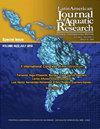移植到健康状况不同的珊瑚礁中的大叶藻类转录组特征:全生物体水平的潜在压力指标
IF 0.8
4区 农林科学
Q3 FISHERIES
Latin American Journal of Aquatic Research
Pub Date : 2024-02-29
DOI:10.3856/vol52-issue1-fulltext-2991
引用次数: 0
摘要
当务之急是了解珊瑚适应导致珊瑚白化的环境压力的潜力。珊瑚全缘体对这种压力条件的分子反应决定了共生的成败。因此,通过描述全生物体水平的分子压力反应,我们可以开发出更好的工具来诊断其健康状况和恢复能力。然而,对于东热带太平洋的造礁珊瑚,目前只有一些基因组规模的资源。本研究旨在对移植到墨西哥科利马岛不同健康状况环境中的 Pocillopora grandis holobiont 进行转录组表征。研究人员在健康状况良好的卡里萨莱斯珊瑚礁采集了两种颜色形态(绿色和棕色)的健康标本。来自这两种形态的珊瑚碎片在原产地被重新安置(当地移植压力)。相反,类似的碎片被移植到另一个健康状况较差的珊瑚礁 La Boquita。24 小时后,收集移植片段,并使用 Illumina 系统进行 RNA 序列分析。进行了全新转录组组装、功能注释、共表达模块鉴定和分子通路富集分析。对 rRNA LSU、rRNA SSU 和 COI 序列的分析确认了珊瑚的种类,而对 Rubisco、psbA 和 psaA 转录本的分析表明,主要的内共生体是 Durusdinium sp.。本文所提出的转录组指标对于进一步研究Pocillopora珊瑚对全球变化的适应性很有价值。本文章由计算机程序翻译,如有差异,请以英文原文为准。
Transcriptome characterization of Pocillopora grandis transplanted into reefs with different health conditions: potential stress indicators at the holobiont level
Understanding the potential of coral to adapt to environmental stressors that cause coral bleaching is urgent. The molecular responses of the coral holobiont to such stress conditions determine the success of symbiosis. Therefore, by characterizing molecular stress responses at the holobiont level, we can develop better tools to diagnose its health and resilience. However, only some genomic-scale resources are available for reefbuilding corals from the Eastern Tropical Pacific. This study aimed to perform a transcriptomic characterization of the Pocillopora grandis holobiont following transplantation into environments with different health conditions in Colima, Mexico. Healthy specimens of two color morphotypes (green and brown) were collected in Carrizales, a reef in good condition. Coral fragments from the two morphotypes were relocated within the source location (local transplant stress). In contrast, similar fragments were translocated into another reef with a poorer health state, La Boquita. After 24 h, the transplanted fragments were collected, and RNA-seq was performed with the Illumina system. De novo transcriptome assembly, functional annotation, identification of co-expression modules, and enrichment analysis of molecular pathways were performed. The analysis of rRNA LSU, rRNA SSU, and COI sequences confirmed the coral species, whereas analysis of Rubisco, psbA, and psaA transcripts revealed that the dominant endosymbiont was Durusdinium sp. Gene expression patterns observed across samples suggest that the transplantation to a reef with a poorer state of health affected processes such as photosynthesis, calcium homeostasis, and immune response. The transcriptomic indicators proposed here are valuable for further studies examining the adaptation of Pocillopora corals to global changes.
求助全文
通过发布文献求助,成功后即可免费获取论文全文。
去求助
来源期刊

Latin American Journal of Aquatic Research
FISHERIES-MARINE & FRESHWATER BIOLOGY
CiteScore
1.70
自引率
10.00%
发文量
44
审稿时长
4-8 weeks
期刊介绍:
Latin American Journal of Aquatic Research- LAJAR is the continuation of the journal Investigaciones Marinas (1970-2007) and is published since 2008 by the Escuela de Ciencias del Mar, Facultad de Ciencias del Mar y Geografía of the Pontificia Universidad Católica de Valparaíso. LAJAR is an “Open Access” journal that publishes in English language, original research articles, reviews and short communications on aquatic science, which contain the results of research conducted in aquaculture or in oceanic and coastal marine waters of Latin America.
The following topics are considered: Physical Oceanography, Chemical Oceanography, Marine Biogeochemistry, Marine Pollution and Toxicology, Marine Geology and Geophysics, Biological Oceanography, Fisheries and Aquaculture.
 求助内容:
求助内容: 应助结果提醒方式:
应助结果提醒方式:


